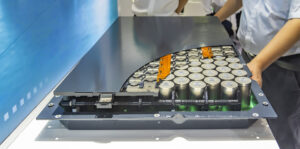
Document released to support safe handling, storage of EV batteries
By onRepair Operations
A new document was published to offer guidance on the safe handling and storage of electric vehicle (EV) batteries.
The report was produced by a Suppliers Partnership for the Environment (SP) working group which included OEMs such as General Motors, Honda Development and Manufacturing of America, Stellantis, and Toyota. Other participants included companies involved in the EV value chain.
The free 25-page report, available for download online, contains information about how batteries should be handled after they’re removed from a vehicle. This includes things like battery identification, safety prevention, and the roles of authority.
Also laid out in the report are tips for spotting thermal event batteries, which can explode and cause fires. It said shops should regularly look out for batteries that:
-
- Are dented, punctured or cracked on the outer shell;
- Are leaking fluid from the battery pack;
- Have water damage or corrosion on the terminals;
- Have loose wiring inside the battery pack or sticking out from the pack; or
- Show signs the battery was opened and worked on.
It also encourages places like shops to develop a plan to respond to thermal runaway fires, chemical leaks, and gas emissions that can be caused by lithium-ion batteries.
Having thermal imaging cameras, four-gas meters, vehicle fire blankets, fire retardants, and overhead sprinkles on hand are among the ways shops can prepare themselves, the report said, noting the consequences faulty batteries might have on handlers.
“High-voltage batteries can present significant risks if mishandled. Lithium-ion EV batteries can pose chemical, thermal, and electrical hazards,” the report says. “Handlers of EV batteries can be divided into two groups: those a) responsible for the movement and storage of the batteries and b) responsible for the work performed on the battery including its removal from a vehicle.”
If repair shops do experience a thermal event, they can end the runaway by letting the battery burn itself out, spraying the battery with a hose, or placing it in a tub of water, the report said.
It shared mitigation strategies as well, including reducing a battery’s state of charge before storing it, maintaining a cool storage environment below 80 degrees Fahrenheit, storing batteries with proper terminal protection to prevent shocks, and spacing batteries apart to minimize the risk of a thermal event propagating.
SP said the document was written with those who handle EVs, which of course includes collision repairers, in mind.
“High-voltage batteries can present significant risks if mishandled and taking proactive steps such as developing a comprehensivfe emergency preparedness and fire prevention plan is key in mitigating those risks,” said David Fauvre, co-founder and chief strategy officer at Blue Whale Materials, which co-chaired the committee.
“Items like appropriate PPE and tools and materials for thermal runaway identification, containment, and extinguishing play an important role in minimizing potential hazards as well. This document was designed to help educate others on some of the key safety prevention factors they may want to consider when handling EV batteries.”
The report covers lithium-ion batteries as well as plug-in hybrids and hybrid electric vehicles for passenger vehicles. SP said that its guidance could apply to other types of lithium and nickel metal hydrid batteries as well.
“Advancing best practice in the responsible management of electric vehicle batteries is a priority for SP and our member companies, particularly as the number of EV batteries reaching end of life begins to increase over the coming years,” said Kellen Mahoney, SP director.
During a Collision Industry Conference (CIC) seminar earlier this year, panelists shared safety tips specifically geared toward repairers working on EVs.
Image
Main image courtesy of iStock/kynny
